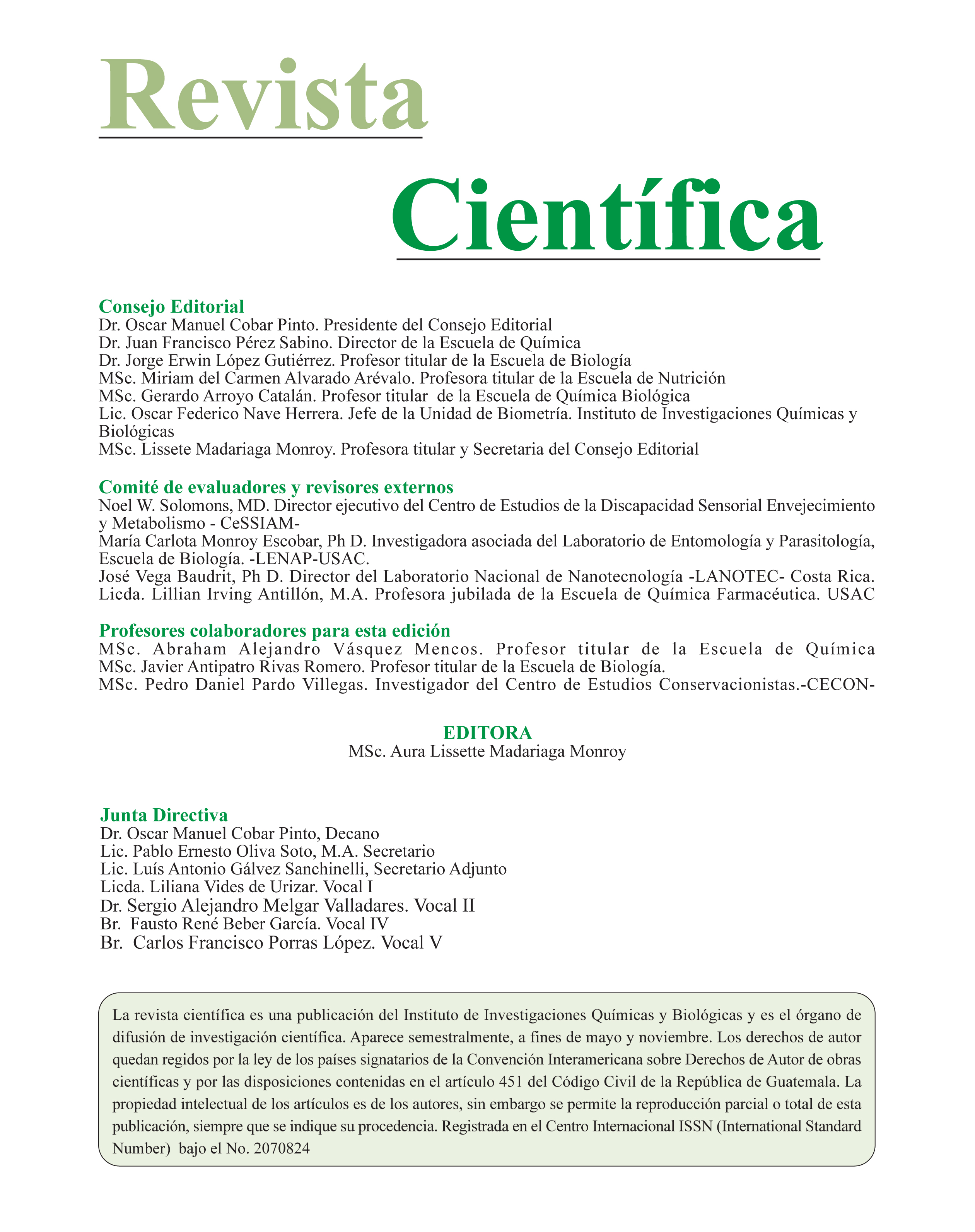Synthesis of polymer chitosan nanoparticles funtionalized with blackberry extracts(Rubus glaucus) and its preliminary evaluation as antimicrobial agents
DOI:
https://doi.org/10.54495/Rev.Cientifica.v22i1.126Keywords:
antimicrobial agents, polyphenols, bacteriostatic effect, chitosan, polimeric nanoparticlesAbstract
The aim of this study is to evaluate the bacteriostatic effect of functionalized chitosan nanoparticles with antioxidants from tropical fruit extracts. In the synthesis and characterization of functionalized chitosan nanoparticles variables are treated in order to obtain concentrations and other parameters, which shows bacteriostatic effect on some species of pathogenic gram-negative ATCC bacterias: Escherichia coli, Serratia marcescens and Pseudomona aeroginosa, and gram-positives: Staphylococcus aureus, Bacillus subtilis and Enterococcus faecalis. The hypothesis assumes that functionalized nanoparticles synthesized according to the ion gelation method using tripolyphosphate as crosslinking agent, with modifying agents from blackberry tropical fruit extracts (Rubus glaucus), containing antioxidants, expressed as gallic acid concentration, provides chitosan nanoparticles the ability to inhibit bacterial growth. This research performed a preliminary evaluation of the polyphenol content and antimicrobial activity in conjunction with the nanoparticles against pathogens mentioned above. The evaluated fruits exhibit concentrations of 100 mg of gallic acid/100g and antimicrobial activity against the gram-positive S. aureus E. faecalis and B. subtilis, and the gram-negative S. marcescens determined by disc diffusion method showing an inhibition diameter between 10% and 60 % compared to positive control. These results show the potential of these nanoproducts as antimicrobial agents for use in the pharmaceutical industry.
Downloads
References
Armentia, A., Lombardero, M., Barber, D., Callejo, A., Vega, J., Martínez, C., y Rebollo, S. (1999). Anafilaxia por moras (Morus nigra). Alergologia e Inmunologia Clinica 14, 98-401.
Begin, A., y Calsteren, M. R. (1999). Antimicrobial films produced from chitosan. International Journal of Biological Macromol, 26, 63-67. https://doi.org/10.1016/S0141-8130(99)00064-1 DOI: https://doi.org/10.1016/S0141-8130(99)00064-1
Fuentes, L. B., y Pastor de Abram, A. (2004). Preparación, caracterización y evaluación de películas de quitosano proveniente de calamar gigante “Dosidicus gigas” para uso médico. Revista de la Sociedad Química del Perú. Per, 75 (1).
Gutierréz, B. A. (2002). Chocolate, polifenoles y protección a la salud. Acta Farmacèutica. Bonaerense, 21 (2), 149-52.
Márquez, C., Cartagena, J., y Pérez, M. (2009). Efecto de recubrimientos comestibles sobre la calidad en poscosecha del níspero japonés (Eriobotrya japonica T.). Revista de la Facultad de Química Farmaceútica, 16, 304-310.
Peniche, C., Argüelles, W., Peniche, H., & Acosta, N. (2003). Chitosan: An Attractive Biocompatible Polymer for Microencapsulation. Macromolecular Bioscience, 3, (10), 511–520. https://doi.org/10.1002/mabi.200300019 DOI: https://doi.org/10.1002/mabi.200300019
Hassan, E., Parish, R., & Gallo, R. (1992). Optimized formulation of magnetic chitosan microspheres containing the anticancer agent, oxantrazole. Pharmaceutical Research, 9, 390-397. https://doi.org/10.1023/A:1015803321609 DOI: https://doi.org/10.1023/A:1015803321609
Rinaudo, M. (2008). Main properties and current applications of some polysaccharides as biomaterials. Polymer. International. 57, (3), 97-430. https://doi.org/10.1002/pi.2378 DOI: https://doi.org/10.1002/pi.2378
Madrigal, S., Rodríguez, G., Krueger, C., & Reed, J. (2010). Evaluation of Costa Rican Traditional Fruits as potencial sources of natural polyphenolic antioxidants and antimicrobials. Inventi Journals, 1.
Ohya, Y., Takei, T., Kobayashi, H., & Ouchi, T., (1993). Release behavior of 5-fluorouracil from chitosan-gel microspheres immobilizing 5- fluorouracil derivative coated with polysaccharides and their cell specific recognition. Journal of Microencapsulation 10, 1-9. https://doi.org/10.3109/02652049309015307 DOI: https://doi.org/10.3109/02652049309015307
Downloads
Published
How to Cite
Issue
Section
License
Copyright (c) 2012 M. Porras, S. Madrigal, J. Vega

This work is licensed under a Creative Commons Attribution 4.0 International License.
Authors who publish with this journal agree to the following terms:
- Authors retain copyright and grant the journal right of first publication with the work simultaneously licensed under a Creative Commons Attribution License 4.0 that allows others to share the work with an acknowledgement of the work's authorship and initial publication in this journal.
- Authors are able to enter into separate, additional contractual arrangements for the non-exclusive distribution of the journal's published version of the work (e.g., post it to an institutional repository or publish it in a book), with an acknowledgement of its initial publication in this journal.
- Authors are permitted and encouraged to post their work online (e.g., in institutional repositories or on their website) prior to and during the submission process, as it can lead to productive exchanges, as well as earlier and greater citation of published work.









